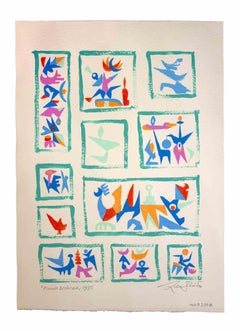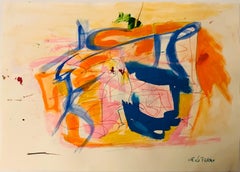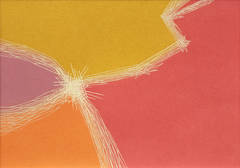Raymond Jonson Abstract Paintings
American, 1891-1992
Raymond Jonson (1891-1982) is best known as one of the founders of the Transcendental Painters Group in Santa Fe, where he settled in 1924 and painted works that were pure abstraction. Before this time, he was in Chicago for fourteen years and there had many formative experiences that led to his later career. His mentor in Chicago was modernist B.J.O. Nordfeldt, and he was much affected by the Armory Show Exhibition of 1913 when it traveled to Chicago.to
1
Overall Width
to
Overall Height
to
1
1
1
1
1
2
666
627
362
342
1
1
Artist: Raymond Jonson
Raymond Jonson Abstract Watercolor, 1941 - Casein Tempera No. 1
By Raymond Jonson
Located in Phoenix, AZ
Great abstract work by Transcendental painter Raymond Jonson (1891-1982)
Titled: “Casein Tempera No. 1”. Medium: Tempera. Dated: 1941.
Image measures: 30" H x 22" W. Frame measures: ...
Category
Mid-20th Century Abstract Raymond Jonson Abstract Paintings
Materials
Tempera
Related Items
Piccolo Archivio - l Artwork by Leo Guida - 1988
By Leo Guida
Located in Roma, IT
Piccolo Archivio is an original Contemporary artwork realized in 1988 by the italian Contemporary artist Leo Guida (1992 - 2017).
Original drawing in beautiful colored tempera o...
Category
1980s Abstract Raymond Jonson Abstract Paintings
Materials
Tempera, Cardboard
Mixed Colors Composition - Tempera by Giorgio Lo Fermo - 2020
By Giorgio Lo Fermo
Located in Roma, IT
Mixed Colored Composition is an original artwork realized by Giorgio Lo Fermo (b. 1947) in 2020.
Mixed media in tempera and watercolor on paper
Hand-signed by the artist on the low...
Category
2010s Abstract Expressionist Raymond Jonson Abstract Paintings
Materials
Tempera, Watercolor, Paper
$574
H 8.27 in W 11.62 in D 1.19 in
The Room of Metamorphosis - Tempera by Leo Guida - 1998
By Leo Guida
Located in Roma, IT
The Room of Metamorphosis is an original contemporary artwork realized in 1998 by the italian artist Leo Guida (1992-2017).
Original mixed colored tempera.
Study of colors for the ...
Category
1990s Abstract Raymond Jonson Abstract Paintings
Materials
Tempera
$777
H 39.38 in W 39.38 in D 0.04 in
Paese in estate - Artwork by Leo Guida - 1988
By Leo Guida
Located in Roma, IT
Paese in estate is an original Contemporary artwork realized in 1988 by the italian Contemporary artist Leo Guida (1992 - 2017).
Original drawing in beautiful colored tempera on...
Category
1980s Abstract Raymond Jonson Abstract Paintings
Materials
Tempera, Cardboard
Abstract Composition - Painting by Leo Guida - 1970s
By Leo Guida
Located in Roma, IT
Abstract composition is an original contemporary artwork realized by Leo Guida in 1970s
Mixed colored tempera on plywood.
Leo Guida (1992 - 2017). Sensitive to current issues, art...
Category
1970s Abstract Raymond Jonson Abstract Paintings
Materials
Tempera
$2,152
H 15.75 in W 19.3 in D 0.79 in
The Room of Metamorphosis - Original Tempera by Leo Guida - 1980
By Leo Guida
Located in Roma, IT
The Room of Metamorphosis (Original title: La Stanza delle Metamorfosi) is an original Contemporary artwork realized in 1980 by the italian artist Leo Guida (1992 - 2017)
Original ...
Category
1980s Abstract Raymond Jonson Abstract Paintings
Materials
Tempera
$1,674
H 27.56 in W 35.44 in D 0.04 in
Composition in Black - Tempera by Clement Nicolas Kons - 1920s
By Clement Nicolas Kons
Located in Roma, IT
Composition in black is an artwork realized by Clement Nicolas Kons in 1920s.
Original mixed colored tempera.
Good conditions except for some so...
Category
1920s Abstract Raymond Jonson Abstract Paintings
Materials
Tempera
$298
H 18.9 in W 15.95 in D 0.04 in
Armony in Blue and Red - Tempera by Clement Nicolas Kons - 1920s
By Clement Nicolas Kons
Located in Roma, IT
Armony in blue and red is an original artwork realized by Clement Nicolas Kons in 1920s.
Original mixed colored tempera. The artwork is glued on ...
Category
1920s Abstract Raymond Jonson Abstract Paintings
Materials
Tempera
$298
H 9.26 in W 9.06 in D 0.04 in
Liberation - Tempera by Contempologyc E.M. - 2020
By Contempologyc E.M.
Located in Roma, IT
Liberation is one of the best tempera paintings on paper realized by Contempologyc E.M. in 2020.
The art of the author, barely held back by a sketched frame that imprisons her, expl...
Category
2010s Abstract Raymond Jonson Abstract Paintings
Materials
Tempera
$502
H 11.82 in W 8.27 in D 0.08 in
Blue Circle - Tempera by Clement Nicolas Kons - 1920s
By Clement Nicolas Kons
Located in Roma, IT
Blue Circle is an artwork realized by Clement Nicolas Kons in 1920s.
Original mixed colored tempera.
Good conditions except for yellowing of p...
Category
1920s Abstract Raymond Jonson Abstract Paintings
Materials
Tempera
$298
H 13.39 in W 11.42 in D 0.04 in
Abstract Composition -Original Tempera and Watercolor by Giorgio Lo Fermo - 2021
By Giorgio Lo Fermo
Located in Roma, IT
Abstract Composition is an original drawing in Tempera and Watercolor on paper realized by Giorgio Lo Fermo in 2021.
Good Conditions.
The Artwork is Depicted through strong strokes...
Category
2010s Abstract Raymond Jonson Abstract Paintings
Materials
Tempera, Watercolor
$693
H 19.69 in W 27.56 in D 0.08 in
Colore - Tempera by Leo Guida - 1970s
By Leo Guida
Located in Roma, IT
Colore is an original Contemporary artwork realized in the 1970s by the italian artist Leo Guida (1992 - 2017).
Original Painting in Tempera.
Total dimensions: 70 x 0.1 x 40 cm.
T...
Category
1970s Abstract Raymond Jonson Abstract Paintings
Materials
Tempera
Previously Available Items
Oil No. 9
By Raymond Jonson
Located in Denver, CO
Framed dimensions measure 23.5 x 31.5 inches.
Expedited and International Shipping available; please contact us for a quote.
About the artist:
Seeking the spiritual in art, Raymond Jonson developed an abstract style of painting that was unique in pre-1940s New Mexico. While his colleagues in the Transcendentalist Painting Group similarly shared his interest in the metaphysical, Jonson alone found his means in a non-objective relationship of forms. Strongly influenced by Kandinsky, the painter moved from stylized representations of nature to formalist expressions of universal harmony. In order to achieve his aims, he became a master of materials, known for his meticulous working methods.
Born in Iowa, Jonson spent his early years moving around the country with his family, necessitated by his minister father's work. They finally settled in Portland, Oregon, in 1902, and this same year Raymond had a spiritual experience in which he sensed the presence of God. When his family's Baptist faith disappointed him, he transposed this feeling to art, to which he committed his life. When the Portland Art Association established its Museum Art School, Jonson enrolled as its first student.
His dedication led him to Chicago to study at the Academy of Fine Arts, a very good commercial school, which afforded a strong grounding in drawing. Here he met B.J.O. Nordfedlt, a Swedish immigrant, who introduced the younger Jonson to the colorist experimentation of the Fauves. The Arthur Dove exhibition and the Armory Show brought to Chicago both expanded his awareness of the emotive possibilities of modernist art movements.
From 1912 to 1917, Jonson was lighting, stage set, costume, and graphics designer for the Chicago Little Theater, America's first experimental theater. Among their bold departures was a minimalist aesthetic, which reduced the stage elements and enhanced the dramatic content with light. Devising the 9-switch dimmer board, Jonson (going by C. Raymond Johnson) became an international theater figure. He also met his wife, Vera White, secretary for the theater and poet.
On a trip to the Colorado Rockies in 1917, Jonson was moved by the power of this sublime landscape and its clarity of light. He began to consider how paint could express light -- material into immaterial. Teaching at the Chicago Art Institute, he was able to get away to the MacDowell Art Colony in 1919, and his elevated sensibilities increasingly perceived the oppressive side of city life. Believing the aim of life was toward harmony, Jonson placed new emphasis on design as a unifying principle. Reading Kandinsky's "The Art of Spiritual Harmony" further convinced him that the mission of art was to make this harmony visible.
In 1922, he spent the entire summer in Santa Fe, and his experience there filtered into his work upon returning to Chicago. When his mother supplied the money for a studio, he moved to New Mexico in 1924, building his home across the street from his friend Nordfeldt. Jonson pursued the concept of order as found in "simple basic motives of spaces and interesting variety of shapes and spaces, a balance of line direction."
In the work of the late 20s, he submits natural forms, such as mesas and even the Grand Canyon, to a dynamic patterning in which the quality of light becomes a design element. Significantly, Jonson thought that emotion could be included by creating juxtaposed rhythms within the composition. Influenced by Indian design, these paintings recall Art Deco ornamentation in the combination of organic and geometric motifs and the electric color effects.
Taking the next leap, Jonson set about purifying his work of all representation. Beginning in the thirties, he explored new ways applications of color and tonality to suggest the quality of transparency, which created the sense of different planes within one surface. Philosophically, this transparency was the artistic means to "expose the spirit of man." Carefully painting gradations, he achieved luminosity and, with colors close to each other, vibration. He eventually used an airbrush for further ethereal effects. Rather than suggest the metaphysical with subject matter, Jonson proposed an approach to painting which de-materialized the actual physical object. In 1938, he and Emil Bisttram were the core of the Transcendentalist Painters Group, which advanced these principles among other artists in Santa Fe and Taos.
As advocate and impresario, Jonson casts a long shadow. Although there was strong sentiment against it, he organized the modern wing of the Museum of New Mexico. In 1934, he painted six murals for the University of New Mexico, which began his relationship with the Albuquerque institution. For many years, he commuted there from Santa Fe but in 1950 he moved there to the gallery/studio provided. Upon his retirement in 1954, he continued to stage exhibitions, thus making the gallery a citadel of modernism in the Southwest. The building itself is a landmark of Pueblo Revival...
Category
1950s Abstract Expressionist Raymond Jonson Abstract Paintings
Materials
Alabaster
Watercolor, NO. 20
By Raymond Jonson
Located in Denver, CO
Provenance:
Private Collection, Colorado
Category
1940s Abstract Raymond Jonson Abstract Paintings
Materials
Watercolor
Raymond Jonson abstract paintings for sale on 1stDibs.
Find a wide variety of authentic Raymond Jonson abstract paintings available for sale on 1stDibs. Customers who are interested in this artist might also find the work of William (Bill) Alpert, Doug Frohman, and Carolanna Parlato.



